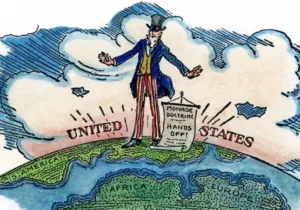ISIS continues to wage war in the Middle East and incite violence around the globe.
Russia annexes Crimea, invades Eastern Ukraine, commits cyber-attacks against the U.S., and worries NATO states with provocative military actions in air, sea and on land.
China builds and modernizes its military forces as it seizes control of islands and waters over which it has no legitimate sovereignty.
Iran, emboldened by the flawed nuclear deal with the U.S., maintains its nuclear aspirations and ballistic missile programs and continues to sponsor terrorism throughout the Middle East.
North Korea continues to expand and improve both its nuclear weapons and ballistic missiles.
These are among the threats recognized in the Heritage Foundation’s 2017 Index of U.S. Military Strength, which assesses our military’s ability to protect American citizens and interests around the globe. The Index finds global threats rising and military strength declining for a third straight year.
Our waning military strength and “lead-from-behind” foreign policy has emboldened our adversaries and opened new opportunities for them to assert their regional influence. It is therefore imperative that America resolves to strengthen its national defense.
In the post-World War II era, the United States experienced a surge in economic prosperity and defense of freedoms that yielded growth across the globe and culminated with the fall of the Soviet Union. U.S. military presence over that time also provided security of the global commons—sea, air, space, and cyberspace—which allowed the world economy to grow rapidly. Meanwhile, Washington backed security alliances such as NATO. That facilitated regional stability, which in turn kept threats away from U.S. borders.
Yet under the Obama Administration, a combination of budget cuts, Washington gridlock, and the insistence that climate change was the top national security priority have resulted in a military that is smaller, older, and less ready to defend the nation—even as America’s political leadership expects the armed forces to do the same amount of work. This is wrong for a number of reasons.
First and foremost, this fails to fulfill the responsibilities of the federal government. Though the Constitution primarily seeks to limit the national government’s power, there is one responsibility that it actively requires: “provide for the common defence.” The government is further compelled “To provide and maintain a Navy,” and “To raise and support Armies.”
The Constitution also calls upon the government to “promote the general welfare.” While this phrase is often cited to justify government spending on social policies, the military has actually promoted this welfare by securing the space through which the global economy flows and by helping free societies to flourish.
The military has advanced American prosperity since the time of our nation’s founding. This was evident in the government’s decision to begin building a legitimate navy at the end of the 18th century.
Two factors played into this decision. First, the British, French, and other extant naval powers exerted too much control over our young nation’s trade-reliant economy. Control of sea lanes and the ability to blockade key ports were two instruments of power that these nations used against America.
More directly, pirates of the Northern African Barbary states were disrupting America’s export market, which was heavily reliant on the Mediterranean Sea to ship tobacco, rum, and other goods of the New World to European nations. The government initially addressed this through ransom payments for hostages and buying safe passage for vessels, as Americans were weary of the expenses required to field a navy and the debt and taxes necessary to pay for them.
Ultimately, U.S. leadership decided that maintaining the status quo would only increase the pirates’ appetite for exploitation. The government therefore contracted for six frigates to defend its citizens’ safety and economic interests abroad. This decision later enabled the U.S. Navy to challenge the Royal Navy’s supremacy during the War of 1812. This in turn solidified America’s status as a global power.
American history is filled with similar examples demonstrating the benefit of maintaining a strong military. We must not let this strength erode further.
How can this be accomplished? It will take a refocused effort from Washington to provide our service members with the resources necessary to maintain an overwhelmingly capable fighting force. This is important for a number of reasons.
First, it is in our interest to overwhelmingly defeat whatever adversary we face. This is not only pragmatic; it is also a moral necessity at both tactical and strategic levels. Tactically, if civilian government leadership puts service members in potentially mortal danger, it is a moral imperative to enable those service members to be superior to their adversaries.
The consequences of not doing so have become sadly clear in recent years. They are seen in an increase in fatal helicopter accidents caused by insufficient maintenance and pilot training. Though service members pledge to put their lives potentially at risk to protect the nation, it is both wrong and wasteful to send them into harm’s way underhanded or ill-equipped.
Providing overwhelming force is also prudent at a strategic level. The Index of U.S. Military Strength measures military strength against a benchmark ability to win two wars nearly simultaneously.
This standard does not arise out of a desire to go to war. Rather, it serves as an insurance policy based on a few prudent assumptions. First, it humbly acknowledges that we cannot predict what the next war will be. As former Defense Secretary Robert Gates put it, “When it comes to predicting the nature and location of our next military engagements, since Vietnam, our record has been perfect. We have never once gotten in right.” Accepting this logically begets a broad military strategy that provides a large and diverse set of capabilities to handle myriad challenges.
Second, the two-war construct acts as a deterrent. If the U.S. is capable of winning only one major war at a time, it makes American leadership doubly hesitant to commit forces in any one engagement, lest it expose itself to too much risk elsewhere. Additionally, if the U.S. military can commit to only one major war at a time, an adversary in another part of the world might take that opportunity to disrupt its own region.
America benefitted from a similar military force when it found itself at war in Korea and Vietnam, all during the Cold War. Despite major commitments of force to Asia, the remaining American military presence in Europe and elsewhere deterred the Soviet Union from threatening NATO. Thus, this large global force both protects Americans at home while deterring the outbreak of major conflict abroad. This is why George Washington and others repeated the ancient Roman adage: “If you want peace, prepare for war.”
American military power is critical to securing the American homeland, preserving American economic and political interests at home and abroad, and securing the global commons upon which our nation and the rest of the world benefit. The government must reverse the erosion of military strength in recent years to uphold its constitutional responsibilities and maintain peace.
—
Brian Slattery is a Policy Analyst for National Security in the Center for National Defense at The Heritage Foundation. He manages the production of the annual Index of U.S. Military Strength. Prior to joining Heritage, Slattery served as a Defense Research Assistant for Congressman J. Randy Forbes. Brian earned a Bachelor of Arts degree in International Affairs with a business concentration from Xavier University. He earned a Master of Public Policy degree with a focus in national security from George Mason University. He and his wife Elizabeth live in Silver Spring, MD.
Photo Credit: Guided-missile destroyer USS Gonzalez transits the Indian Ocean on Jan. 27, 2016. U.S. Navy photo by Mass Communication Specialist 3rd Class Pasquale Sena.





